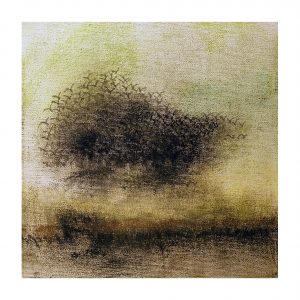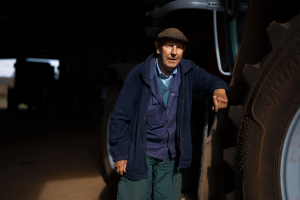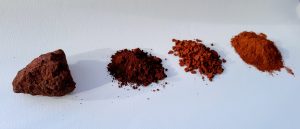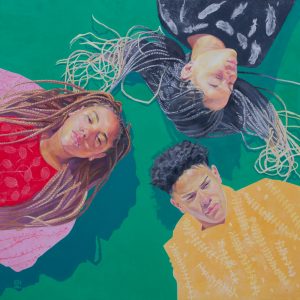James Hughes
Photographer & Artist
On Myth, Memory, and the Uncommercial Eye: Photographer James Hughes on Forty Years of Image-Making Across Time, Place, and Protest

“I used to work for PWC in Belfast,” begins James Hughes. “And now I’ve retired, I’m busier than I ever was.” With over forty years of experience behind the camera, Hughes has cultivated a life in photography marked by passion and perseverance.
Hughes started with newspapers and weddings but soon turned away from commercial demands. “I didn’t like the commercial aspeect. So it was nice to be able to do what I love… like fine art, reportage, documentary.” Reflecting on his long professional life in photography, he notes, “Now I can just concentrate full time.”
In his early years, Hughes was a regular at live gigs, capturing icons like AC/DC in 1979. “You remember doing AC/DC 79, Bon Scott, doing you know, people like that,” he recalls. “I really loved my music, so…” At that time, it was much easier to photograph gigs: “You could smuggle your camera in and you could get in easier.” Hughes also shot Prince for a magazine based in Cork. “You were allowed up for three songs and then you had to get out,” he explains. He remembers the experience fondly: “It was, you know, a passion again, you know.” Rory Gallagher was another figure who left a lasting impression. “Met Rory twice. Great to be able to see those people.” But the live music world has changed: “Yeah, I think it’s a different thing. It’s moved into a different era, a different time. Even the accessibility is different. You know, I still enjoy it, and I would still take a notion – I still do the odd one.”
Even today, Hughes occasionally returns to concerts, albeit with a slower, more deliberate pace. “Back in the day it was film photography… and you had to be spot on. You couldn’t see what you were doing.” He fondly recalls the incredible lighting at a Queen gig in Dublin and compares it with the challenge of shooting in bars “where there was maybe just one lightbulb.”
His guiding philosophy in portraiture: “Get as close as you can… go further in and out of your comfort zone.”
Slowing down has become his intentional practice. “When I was younger, it was charging all the time. Now I’m slow… and it changes the look, changes the picture.”
Film photography remains a passion. He recalls travelling to New York in 2000 with 100 rolls of film: “It was a pound a roll, a pound to develop it in Snappy’s. And now it’s 30 quid.” Recently, he revived his Olympus OM-1, shooting in Dublin. “Whenever you shoot film, you can’t see what you’ve got, so you keep going… you can actually get something really better.”
Developing has become a rarer pursuit due to the cost of chemicals and papers. Still, he compares the process to cooking: “You have your own recipes. These days, I try and stay out of the darkroom, you know? Yeah, but I still like shooting film.”
Even with an iPhone, Hughes finds magic. A train journey from Tbilisi to Gori in Georgia became a black and white film. “That was the same journey Steinbeck took in ‘47.” The result was a book: Steinbeck’s Georgia: The Stills. A few years ago, he notes, “you couldn’t have done any of that at all… and if it was film it would have cost a fortune.” Thanks to modern digital tools – even an older iPhone capable of shooting 4K – this kind of spontaneous, cinematic storytelling is now possible, opening up new creative possibilities that simply weren’t accessible with traditional film.
His recent exhibition, POSTCARDS (Ghostwritten), in collaboration with poet John Brown, pairs Hughes’ images with fictional postcard writings. “He looked through my archive… and wrote the back of the postcard, really as an imaginary or dead writer.”
The partnership, rooted in years of friendship that began in Belfast bookshops, has resulted in a uniquely layered artistic dialogue. Brown, once literary arts officer for the Arts Council, brought a narrative sensibility that complemented Hughes’ visuals. Together, they created around 100 image-and-text combinations which first appeared at the Fenderesky Gallery and now reside at Roe Valley. “It quite good. It’s a nice collaboration… people seem to enjoy it.”

From the Fenderesky Gallery to Roe Valley and upcoming workshops, Hughes balances sharing techniques with beginners and advanced participants alike through his upcoming workshops, like the PHOTOGRAPHY MASTERCLASS based in the Roe Valley Arts Centre from 10am on Saturday the 7th of June.
Teaching in Istanbul offered a contrast: “There, you had a very rigid framework… whereas this, I can just actually tell them what I do.” Working primarily with teenagers through to degree-level students, he recalls, “you were dictated what you had to teach them.” Despite the restrictions, Hughes found Istanbul to be a vibrant and enriching environment: “Istanbul was very good to me. It was better than here sometimes, even though it’s had its crazy moments.” He remembers the Gezi Park Protests in 2013 vividly: “There was teargas and different things,” he notes. Still, the city’s energy, history, and complexity left a lasting impression on his creative journey.
Cultural immersion defines his work. “Places like Georgia… it’s like being in a movie. A time machine.” Tangier offered “pictures everywhere.” Common themes persist across locations: “wardrobes, beds, ladders.” These recurring elements, often found in domestic or abandoned interiors, act like visual echoes. “You see wardrobes and think of the lives that touched them, the letters left in drawers, the layers of dust on forgotten beds.” Hughes sees these not just as motifs, but as portals into stories – quiet, personal narratives that linger in the architecture and furniture people leave behind.
“I deliberately get lost and then let the pictures find me.”
He anticipates a trip to Palermo, Italy, intrigued by its Moorish influences, vibrant colours, and unresolved war damage. “It’ll actually charge me up,” he says. As with his other travels, he doesn’t plan a route. “I deliberately get lost and then let the pictures find me,” he says. Palermo, with its overlapping histories—from ancient ruins to the scars of the Second World War—offers fertile ground for his process of wandering and quiet observation. “I’ve never been to that part of Italy, so I’m looking forward to that. It’ll be good, you know.”
Hughes is a devoted reader and draws heavily from mythology: “Look at Homer and Dante, and what we have here in Ireland, it’s incredible.” His visit to Troy left a strong impression: “As you arrive all the tourists go into the… Trojan horse and back on the bus. But if you go right round the back… there’s a little path… a whole other world.”
That little path soon revealed something more interesting. “The local villagers go digging at night trying to find things,” he says, describing the discreet, well-worn trail hidden behind the official site. For Hughes, that quiet side path symbolised everything he seeks in his work: stories that go unnoticed, worlds just behind the curtain of what’s been commercialised or codified. “It’s very, very beautiful,” he adds, emphasizing how mythology isn’t just ancient – it’s alive in the everyday, in the spaces that escape the spotlight.
“I need a story,” Hughes states plainly. “A thread to hold it together… the glue to stick the story together, to create a narrative.”
Serendipity and unconscious instinct guide his photography. “The pictures almost dictate to you… you have an unconscious thing going on.”
Exploring the Sperrins, Hughes sees overlooked beauty in “forgotten” places. Recently, he travelled through the region with a group of friends, stopping to take pictures along the winding roads and silent bogs. “Parts of the Sperrins are just empty, you know, there’s nothing there. It’s like forgotten, and you’re trying to find a petrol station.” Passing through small towns, Hughes noticed shuttered shops and a distinct lack of activity. “There’s nothing really happening. But again, it’s very, very beautiful.”
What makes the Sperrins particularly resonant for Hughes is their quiet, unpolished beauty and deep sense of history. These locations are rarely marked on tourist maps; rather, they are found on foot, tucked away beyond roads or deep in the folds of the terrain.
The journey, he says, is a reminder of how much of the country lies unseen by the mainstream. “It’s not even about funding… people haven’t even really been there, just forgotten or whatever.” Yet the Sperrins hold a raw, unfiltered beauty for Hughes – one tied closely to Irish concepts of place and spirituality. “They’re what we call really the Irish idea of a thin place… not just the bogs, but places where there’s a beautiful vibe, a very spiritual one that is thousands of years old.” These are not easy-access tourist spots. “Thankfully, they’re not populated with people because you can’t drive there. A lot of these places, you have to walk.” He recalls walking through the bogs, dodging hazards but finding “just beauty, real beauty.”

“I don’t want to be put in that paradigm.”
For Hughes, institutional funding often comes with expectations that can narrow creative scope or impose predefined outcomes. He prefers to operate independently, shaping his projects according to artistic intuition rather than policy objectives. His collaborations with local museums and councils – like those in Ballymena, Roe Valley, and Waterford – allow him to present authentic work on his own terms, free from the pressures of aligning with agendas. “I don’t want to be put in that paradigm – there’s a sense of freedom in your own work” he says, contrasting this with the more prescriptive models that dominate national arts funding structures.
“In Istanbul… it’s all like the big commercial banks. If they like something, they’ll throw incredible money at it.”
Despite Ireland lacking a commercial art market, Hughes finds audiences abroad. “If somebody here doesn’t like it, I can usually get somebody elsewhere it’s about getting your work out there.”
He worries for emerging artists: “Once you think like that – how are we going to get money out of this? – your work changes… it hasn’t got the same integrity.”
“People say, aren’t you scared to go there? No, not at all.”
He continues to find influence in cinema: “I like foreign films… not so much Hollywood… more to do with slowness and lighting and story.” Directors like Chantal Akerman, Paweł Pawlikowski, Wim Wenders, and Yasujirō Ozu have all shaped his visual sensibilities. “Ever since I saw those I always did my interiors from a very low perspective, often on my knees,” he says, referencing Ozu’s signature low camera angles.
It’s not just technique that speaks to Hughes, but the mood these directors evoke – the pacing, the attention to atmosphere, the way a room breathes or a shadow falls. He responds to the painterly colours of Akerman, the stark compositions of Pawlikowski’s black and white, the emotional restraint of Wenders, and the contemplative poise of Ozu’s domestic interiors. These cinematic influences permeate his photography, lending it a stillness and weight that resists easy consumption.
“Also literature, I read a lot… I tend to like my books and poetry as well.”
Next year, the John Hewitt Society Summer School in Armagh will host an exhibition of Hughes’ portraits of poets and musicians. The show will span years of work, showcasing portraits of literary figures, many of whom are no longer living.
For Hughes, it’s a deeply personal endeavour: “Trying to keep it alive,” he says, referring not just to the subjects, but to the cultural and creative legacy they represent. This body of work captures the richness of local voices and celebrates the artistic spirit of the region—one that Hughes has consistently documented with quiet reverence.
In Ballymena, where affection is sometimes shouted as abuse, Hughes finds groundedness. “You can go anywhere in the world… it’s quite funny in a way.” Growing up and spending much of his life in the area, he’s developed a deep familiarity with its character – both endearing and eccentric. “If you know people, you tend to almost shout abuse at them,” he laughs. “It’s almost a term of affection… in other places you would be in trouble for that.” This uniquely Northern Irish humour and bluntness grounds him, and he reflects fondly on years spent working in local factories, gaining not only resilience but a rare ability to connect with people anywhere. “You can go anywhere in the world,” he repeats. “People say, aren’t you scared to go there? No, not at all. It’s quite funny in a way.”
His observations in Istanbul, where cultural heritage is often at risk of being wiped away by commercial development, resonate with what he now sees in Belfast.
In both cities, Hughes has watched old streetscapes and artist communities give way to corporate interests, often with little regard for the cultural soul of a place. “They don’t care how old or what it is. If there’s money, it’s gone.”
As redevelopment threatens Belfast’s Cathedral Quarter and North Street Arcade, Hughes sees history erased: “It will look like part of New York… not like anything to do with here.” For him, these spaces are layered with cultural memory and artistic possibility – places where people used to gather, share, and create.
The thought of losing them to generic developments troubles him deeply. “There’s lots you could do,” he says. “But it’s the money again. Comes down to money.” It’s a sentiment that closes out the conversation, reflecting the encroachment of commercialisation on place, identity, and the stories worth preserving.
Keep up with the latest news from James via his website: jameshughesfoto.com
Join his upcoming workshop with the Roe Valley Arts & Cultural Centre on the 7th of June: roevalleyarts.com/workshops
See POSTCARDS (Ghostwritten) by James Hughes & John Brown: roevalleyarts.com/events
The Latest Articles

Bob Speers and the Quiet Magic of Ireland’s Bogs
In a room filled with timber, peat, and light, artworks hung on walls are more like fragments of the land itself – weathered, breathing, and alive with memory.

Hernan Farias on Light, Connection and Creative Growth
From the Classroom to the Camera – charting his shift from teaching English in Chile to full-time photography in Northern Ireland.

The Colour & Spirit of Time: Tricia Kelly’s Journey with Ócar
Exploring how sixty million years of volcanic fire, weather, and transformation created the red ochre that now colours Tricia’s life and work.

Faith and Colour: The Genuine Art of Beverley Healy
In her imaginative work, paint becomes prayer – a meditation on trust, surrender, and creation, where colour and stillness meet to form something transcendent.

Ruairi Mooney on Creativity, Practice & the Search for Authentic Art
From the North Coast to the Canvas: a journey of resilience, daily practice, and the slow discovery of an authentic artistic voice.

From Trauma Wards to Ceramics: Denise McAuley’s Authentic Creative Journey
From the trauma wards of the Royal to the shoreline of Cushendall, Denise creates small-batch ceramics that carry memory, resilience, & the rhythms of the sea.

